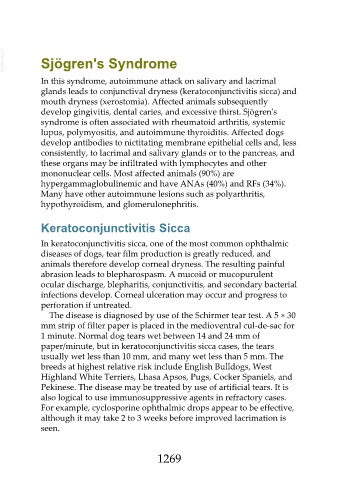Page 1269 - Veterinary Immunology, 10th Edition
P. 1269
VetBooks.ir Sjögren's Syndrome
In this syndrome, autoimmune attack on salivary and lacrimal
glands leads to conjunctival dryness (keratoconjunctivitis sicca) and
mouth dryness (xerostomia). Affected animals subsequently
develop gingivitis, dental caries, and excessive thirst. Sjögren's
syndrome is often associated with rheumatoid arthritis, systemic
lupus, polymyositis, and autoimmune thyroiditis. Affected dogs
develop antibodies to nictitating membrane epithelial cells and, less
consistently, to lacrimal and salivary glands or to the pancreas, and
these organs may be infiltrated with lymphocytes and other
mononuclear cells. Most affected animals (90%) are
hypergammaglobulinemic and have ANAs (40%) and RFs (34%).
Many have other autoimmune lesions such as polyarthritis,
hypothyroidism, and glomerulonephritis.
Keratoconjunctivitis Sicca
In keratoconjunctivitis sicca, one of the most common ophthalmic
diseases of dogs, tear film production is greatly reduced, and
animals therefore develop corneal dryness. The resulting painful
abrasion leads to blepharospasm. A mucoid or mucopurulent
ocular discharge, blepharitis, conjunctivitis, and secondary bacterial
infections develop. Corneal ulceration may occur and progress to
perforation if untreated.
The disease is diagnosed by use of the Schirmer tear test. A 5 × 30
mm strip of filter paper is placed in the medioventral cul-de-sac for
1 minute. Normal dog tears wet between 14 and 24 mm of
paper/minute, but in keratoconjunctivitis sicca cases, the tears
usually wet less than 10 mm, and many wet less than 5 mm. The
breeds at highest relative risk include English Bulldogs, West
Highland White Terriers, Lhasa Apsos, Pugs, Cocker Spaniels, and
Pekinese. The disease may be treated by use of artificial tears. It is
also logical to use immunosuppressive agents in refractory cases.
For example, cyclosporine ophthalmic drops appear to be effective,
although it may take 2 to 3 weeks before improved lacrimation is
seen.
1269

